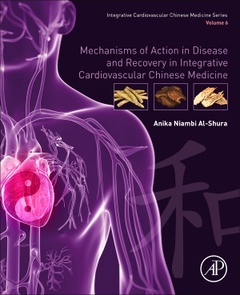Description
Mechanisms of Action in Disease and Recovery in Integrative Cardiovascular Chinese Medicine
Volume 6
Author: Al-Shura Anika Niambi
Language: English
Subject for Mechanisms of Action in Disease and Recovery in...:
154 p. · 19x23.3 cm · Paperback
Description
/li>Contents
/li>Readership
/li>Biography
/li>Comment
/li>
Mechanisms of Action in Disease and Recovery in Integrative Cardiovascular Chinese Medicine, volume six in the Integrative Cardiovascular Chinese Medicine series, presents the structure, function and pathology of the cardiovascular system from Traditional Chinese and Western Medicine perspectives. Sections discuss cardiac acu-anatomy, including cardiac cells and heart structure, gastrointestinal cells and mouth, esophagus, stomach, small and large intestine structures, and more, while other chapters cover the qi, yin and yang roles in cardiac rhythm and pumping actions and the pathology of the heart and vascular system and the zang and fu relationship with other body organs.
This important reference will aid cardiovascular researchers in the study of integrative Chinese and Western medicine with its clear, structured base that will guide clinical practice and encourage collaboration between Chinese and Western medicine practitioners.
Section I: Cardiovascular Anatomy1. Cardiac Cell2. Cardiac Structure3. Cardiovascular System4. Meridians and Acupoints
Section II Cardiovascular Physiology5. Cardiac Rhythm6. Pumping Actions7. Vascular Function and Circulation8. Humeral Control9. Nervous System Regulation
Section III Pathology10. Respiratory System Disorders11. Neurological Disorders12. Nephrotic and Nephritic Disorders13. Hepatic Disorders14. Splenic Disorders
Dr. Al-Shura has 14 continuous years of formal education involving Traditional Chinese Medicine (TCM) clinical practice, advanced medical study, research and education between the United States, Italy and China. In 2004, her master’s degree in Oriental Medicine was earned from East West College of Natural Medicine in Florida, USA. In mainland China between 2004 and 2014, she earned hospital study, advanced scholar and specialty certificates in Chinese medicine, internal medicine and surgery and cardiology from several university affiliated hospitals. Those hospitals include Shandong University of Traditional Chinese Medicine, Shandong Provincial Hospital and Tianjin University of Traditional Chinese Medicine. Her subspecialty training in TCM is in interventional cardiology involving the catherization lab.
Dr. Al-Shura earned her PhD in medical education in 2014 through the University Ambrosiana program. Her dissertation on Integrative Cardiovascular Chinese Medicine (ICCM) became her first textbook entitled, “Integrative Cardiovascular Chinese Medicine: A Personalized Medicine Perspective. This book was one of 7 textbooks written to introduce the concepts of ICCM. All were published and released together through Elsevier Academic Press in 2014. Those textbooks are utilized for the level 1 program studies in ICCM with continuing medical education (CME) courses. Eight additional textbooks were written on the establishment and development of intermediate ICCM theories and practices. Those textbooks are utilized for the level 2 program CME studies in ICCM. Those 8 textbook
- Provides evidence for the mainstreaming of acu-meridian theory and pathophysiology
- Explores the detailed connection between heart dysfunction and the disease mechanisms of other organ systems
- Combines western medicine anatomy and pathophysiology with TCM aspects of essence, qi, blood and body fluid concept, production and function to explain the cardiovascular system dysfunction, it’s independent role and dependent interactions with the functions of other organ systems

